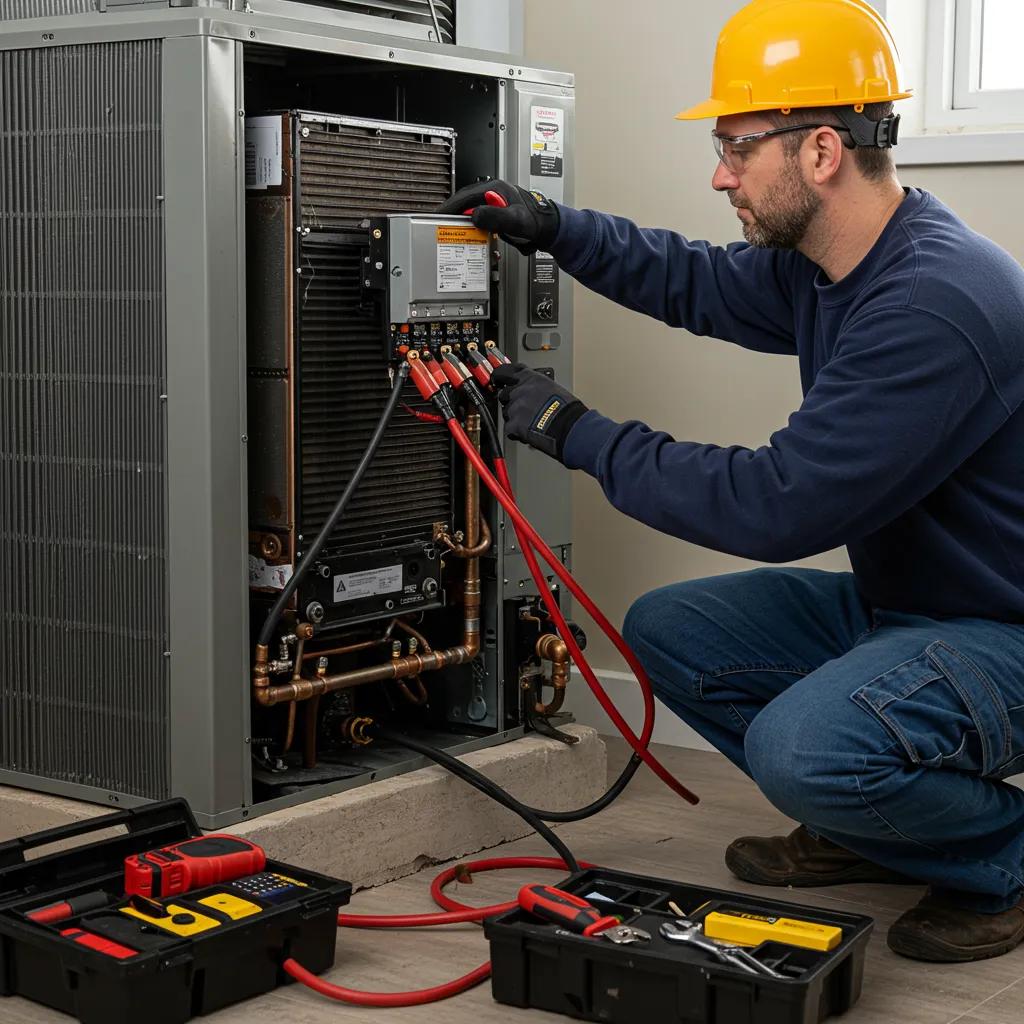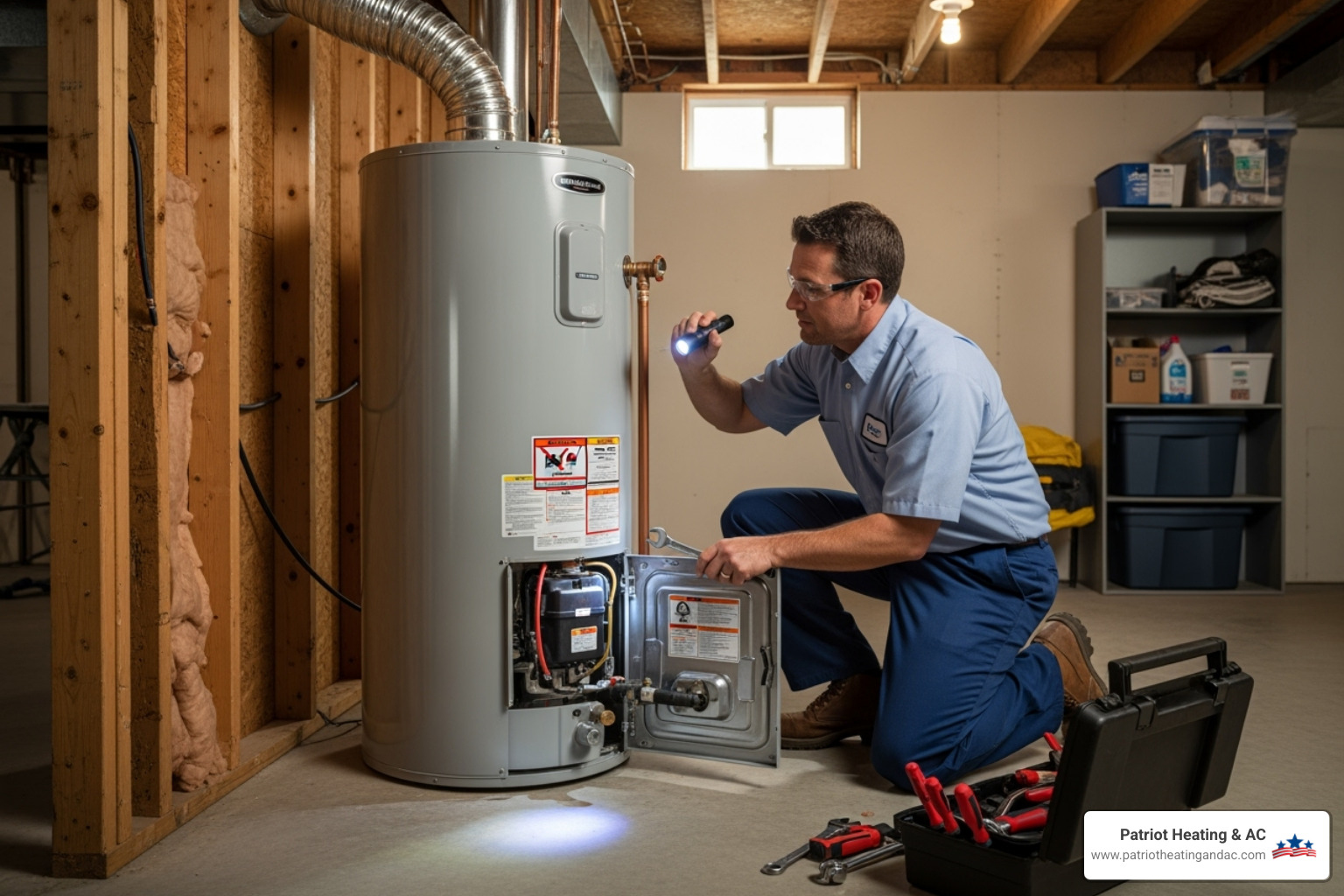.jpg)
Your Guide to a Smart HVAC Maintenance Schedule in Kansas City
An HVAC maintenance schedule is your roadmap for keeping your heating, ventilation, and air conditioning systems running smoothly and efficiently. Think of it as a proactive plan that catches small issues before they turn into big, expensive problems. Regular tune-ups help identify wear and tear, clean vital components, and ensure your system uses less energy, all while keeping your Kansas City home perfectly comfortable. You’ll learn how to map out your year, which tasks you can handle yourself, and when it’s time to call in the pros. Given Kansas City’s dramatic temperature shifts and allergy-season pollen, a well-planned schedule for areas like Shawnee, Olathe, and Lee’s Summit is key to extending your system’s life and maintaining healthy indoor air. This guide lays out a twice-yearly professional check-up, detailed tasks for your furnace, AC, and heat pump, and simple steps you can take, like changing filters and caring for your outdoor unit. We’ll also cover how to prioritize tasks, decide between DIY and professional help, and make the most of service agreements.
Why a Smart HVAC Maintenance Schedule Matters for Kansas City Homes
An HVAC maintenance schedule is your best defense against unexpected breakdowns and high energy bills. By planning regular inspections and tune-ups, you ensure your system operates at peak efficiency, stays safe, and keeps you comfortable year-round. This proactive approach also helps maintain manufacturer warranties and can even boost your home’s resale value. Plus, a well-maintained system is crucial for managing indoor air quality, especially during those challenging pollen and humidity-filled seasons here in the Kansas City Metro. Let’s dive into why this matters locally and what specific actions you should take.
The Big Wins of Preventative HVAC Maintenance

Preventative HVAC maintenance pays off in tangible ways: better energy efficiency, a longer-lasting system, and improved indoor air quality. Simple tasks like swapping out air filters and cleaning coils reduce the strain on your system, leading to lower energy bills and consistent airflow throughout your home. Regular check-ups also catch worn-out parts—like frayed belts or loose electrical connections—before they cause a major failure. Safety is also a priority, with checks on furnaces ensuring they operate correctly. These benefits translate into reliable comfort and predictable costs, which is a huge plus during Kansas City’s demanding summer and winter seasons.
How Regular Care Stops Costly HVAC Breakdowns
Consistent maintenance is your secret weapon against expensive HVAC failures. It works by spotting early warning signs—think clogged filters, low refrigerant, or worn-out motor parts—that can quickly escalate into major repairs if ignored. Our technicians perform detailed diagnostics, checking system pressures, electrical loads, and thermostat accuracy to make precise adjustments before a small issue becomes a breakdown. Keeping components clean and lubricated reduces friction and overheating, while precise calibration ensures your system runs safely and efficiently. Understanding these preventative measures empowers you to act on warning signs before minor glitches turn into costly service calls.
How Kansas City’s Weather Impacts Your HVAC Needs
Kansas City’s extreme weather demands a tailored approach to HVAC care. Spring tune-ups are crucial for your cooling system, preparing it for the summer heat and humidity. As temperatures drop in the fall, it’s time to focus on your heating equipment to ensure it’s ready for winter’s chill. In spring, we’ll focus on cleaning condenser coils, checking refrigerant levels, and calibrating thermostats for optimal summer cooling. Come fall, our attention shifts to your furnace’s ignition system, heat exchanger, and your heat pump’s reversing valve to guarantee safe and reliable winter warmth. These seasonal priorities help your system handle the year-round demands of our local climate.
How Often Should Your HVAC Get Professional Attention?
A smart HVAC maintenance plan balances what you can do at home with essential professional tune-ups. For most homes, we recommend professional service twice a year: once in the spring for your cooling system and again in the fall for your heating system. Supplement this with simple homeowner checks every 1–3 months, focusing on airflow and filter condition. If your system works extra hard, is older, or if indoor air quality is a concern, more frequent professional visits might be beneficial. Service agreements can simplify scheduling and ensure you never miss a crucial appointment, helping you avoid peak-season delays and emergency repairs.
Recommended HVAC Tune-Up Frequency for Kansas City
For most single-family homes in the Kansas City area, aim for two professional tune-ups annually: one for your air conditioner in the spring and another for your furnace or heat pump in the fall. If your home has high occupancy, pets, or significant allergy concerns, consider checking filters quarterly and scheduling professional visits more often. Older systems often benefit from more frequent inspections to catch age-related wear early and maximize their remaining lifespan. This recommended schedule strikes a balance between cost, system protection, and year-round reliability.
How an Annual HVAC Service Agreement Streamlines Your Schedule
An annual HVAC service agreement takes the guesswork out of maintenance by bundling scheduled visits, sending reminders, and offering priority service. This makes upkeep effortless for you. Typically, these agreements include documented tune-ups, service records for warranty purposes, and faster response times, especially crucial during busy seasons. Many agreements also offer cost savings through discounts or bundled pricing, making routine care more predictable. Understanding how these agreements simplify your schedule can help you decide if they’re the right fit for your needs.
When to Call a Pro vs. When to Tackle DIY Maintenance
As a homeowner, you can confidently handle low-risk tasks like swapping out air filters, clearing debris from around your outdoor unit, and checking thermostat settings. Leave the complex work—anything involving electrical components, refrigerant, or combustion—to the professionals. DIY tasks are best when they require basic tools, are easily accessible, and don’t involve refrigerants or live electrical parts. Always call a technician if you notice burning smells, loud grinding noises, persistent pressure issues, or any concerns related to combustion or refrigerant, as these pose safety risks and require specialized expertise. Using this guide helps you maintain safety and system integrity while avoiding unnecessary service calls.
What Makes an HVAC Maintenance Schedule Truly Effective?
An effective HVAC maintenance schedule is a well-organized plan that combines seasonal tasks with component-specific care, blending your DIY efforts with professional tune-ups. It designates spring tasks for your cooling system—like checking coils and refrigerant—and fall tasks for your heating system—such as inspecting ignition and heat exchangers. Routine filter checks are recommended year-round. Clearly separating DIY from professional tasks minimizes risk and ensures that expert inspections catch issues beyond the scope of home maintenance. The detailed HVAC maintenance checklists and guidance below will help you build a practical schedule for your home.
Essential Tasks for a Seasonal HVAC Tune-Up Checklist
A professional seasonal tune-up follows a precise sequence: inspecting and replacing filters, cleaning evaporator and condenser coils, verifying refrigerant levels and system pressures, checking and tightening electrical connections, and testing safety controls. Each step targets common failure points—filters manage airflow, coils impact heat transfer, and electrical checks prevent dangerous arcing or motor issues. The goal is to restore peak efficiency, maintain consistent temperatures, and reduce energy usage. Understanding these steps helps you monitor your system’s performance between professional visits.
Maintaining Key HVAC Components: Furnace, AC, and Heat Pump
Component-specific maintenance addresses the unique needs of each system. Furnaces require checks on combustion and heat exchangers, air conditioners need coil and compressor inspections, and heat pumps require verification of reversing valves, defrost controls, and overall operation. Regular care prevents carbon monoxide risks with combustion units, reduces strain on AC compressors, and ensures heat pumps cycle correctly for defrosting. Proper component care extends the life of your equipment and prevents costly emergency repairs by tackling the most common failure points. Following these component checklists allows for targeted diagnostics and smart repair prioritization.
How Patriot Heating & AC’s VIP Club Membership Elevates Your HVAC Maintenance
Our VIP Club Membership is more than just a maintenance plan; it’s a commitment to proactive care that includes our essential twice-yearly tune-ups, plus priority service and discounts to lower your overall costs and response times. Membership provides two annual tune-ups, priority scheduling, repair discounts, same-day service options, and 24-hour emergency support—all designed to align perfectly with a robust maintenance calendar. For homeowners who prefer a hands-off approach, membership automates reminders and ensures your system receives professional diagnostics at the recommended intervals. Comparing membership benefits to DIY routines and standard service plans highlights the convenience and risk reduction it offers.
Boosting HVAC System Efficiency with Scheduled Maintenance
Scheduled maintenance is key to keeping your HVAC system running at peak efficiency. When components are clean and properly calibrated—like filters, coils, refrigerant levels, and thermostat settings—your system operates within its designed parameters. This means better heat transfer, optimal cooling capacity, and reduced energy waste from short-cycling. These maintenance actions not only lower energy consumption and stabilize indoor temperatures but also reduce wear on critical parts, leading to measurable cost savings over time. Understanding how specific maintenance tasks directly impact efficiency, especially in the Kansas City climate, helps you prioritize the actions that deliver the greatest benefits.
Common HVAC Problems Prevented by a Maintenance Schedule
A proactive maintenance schedule helps prevent common HVAC failures like compressor burnout, ignition issues, clogged drain lines, and worn motor bearings by addressing their root causes before they escalate. Scheduled tune-ups identify unusual wear, clear obstructions, and correct settings that could otherwise lead to mid-season emergencies and expensive repairs. Homeowners benefit from fewer service calls, less frequent emergency repairs, and more predictable operating costs. Understanding these common problems and how maintenance prevents them is key to building a proactive plan for your home.
How Regular Maintenance Avoids Furnace Breakdowns in Winter
Regular maintenance ensures your furnace’s ignition system, burners, and heat exchanger are clean, properly calibrated, and free from cracks or blockages that could cause failure or safety issues. Pre-winter inspections test combustion safety, flue integrity, and burner operation to prevent no-heat emergencies when temperatures plummet. Technicians also check blower motors and controls to guarantee reliable operation during high-demand periods. These safety-critical checks underscore why professional tune-ups are essential before winter arrives.
Signs Your HVAC System Needs Immediate Attention
Warning signs that demand prompt HVAC attention include unusual noises like grinding or banging, burning smells, a noticeable drop in airflow, uneven heating or cooling, and sudden spikes in energy bills that aren’t explained by seasonal use. These symptoms often point to mechanical failures, electrical problems, refrigerant leaks, or airflow restrictions that can worsen quickly without intervention. If you notice any of these signs, prioritize a professional diagnostic to prevent more expensive downstream repairs. Acting quickly on these indicators aligns perfectly with a preventative maintenance mindset.
Minimizing Emergency HVAC Repairs Through Preventative Care
Emergency HVAC repairs can be significantly minimized through early detection of worn components, routine cleaning that reduces mechanical stress, and proactive service agreements that address issues before they lead to system failure. Scheduled tune-ups identify patterns of wear and allow for planned part replacements, reducing the likelihood of mid-winter or mid-summer breakdowns. Memberships or service agreements that include priority scheduling further minimize downtime when unexpected problems do arise. Together, these strategies transform reactive maintenance into predictable, scheduled care that ensures system reliability.
How Often Should I Schedule Preventive Maintenance for My HVAC System?
Schedule professional preventive maintenance twice a year—spring for cooling systems and autumn for heating systems—with homeowner checks (filters and outdoor clearance) every 1–3 months to maintain performance. Adjust frequency upward for older systems, high-usage homes, or indoor-air-quality concerns. This cadence balances risk, cost, and reliability while aligning with seasonal demand cycles in the Kansas City Metro. Following this schedule helps prevent peak-season emergency calls and preserves efficiency.
Why Is HVAC Maintenance Crucial for Kansas City Homeowners?
HVAC maintenance is especially important in Kansas City due to our wide seasonal temperature swings, high humidity, and abundant airborne allergens, all of which increase system workload and stress components throughout the year. Regular maintenance preserves comfort, lowers energy costs, and improves indoor air quality, particularly during peak pollen seasons. It also prevents disruptive winter heating failures and summer cooling breakdowns, which are more common in our region’s climate extremes. Tailoring your maintenance schedule to these local environmental realities ensures optimal performance and protection.
Conclusion
Establishing a comprehensive HVAC maintenance schedule is essential for ensuring the efficiency, safety, and longevity of your heating and cooling systems. By prioritizing regular inspections and timely interventions, homeowners can significantly reduce energy costs and enhance indoor air quality, particularly in the variable climate of Kansas City. Embrace the peace of mind that comes with a structured maintenance plan and consider joining our VIP Club Membership for added benefits and convenience. Contact Patriot Heating & AC today to learn more about our services and how we can support your HVAC needs.
Need Help? Call Patriot.
Call Us At: (913) 214-0883
Discover why so many homeowners trust Patriot Heating & AC with ALL of their Home Heating needs!
Customer Testimonials
See why customers trust our licensed and background-checked technicians and the quality service we deliver every time.
























Customer Testimonials
Latest Blogs


Furnace Maintenance in Leawood KS: Your Winter Warm-Up Crew



.svg)
.svg)

.webp)

